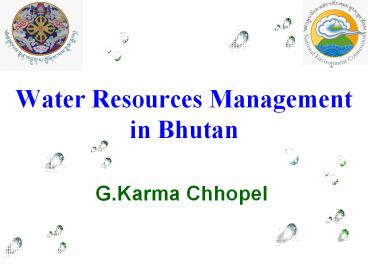Water Resources Management in Bhutan - PowerPoint PPT Presentation
1 / 21
Title:
Water Resources Management in Bhutan
Description:
Title: Slide 1 Author: Ugen P Norbu Last modified by: user Created Date: 9/21/2006 5:27:23 AM Document presentation format: On-screen Show (4:3) Company – PowerPoint PPT presentation
Number of Views:181
Avg rating:3.0/5.0
Title: Water Resources Management in Bhutan
1
Water Resources Management in Bhutan
G.Karma Chhopel
2
Introduction
- Area 38,394km2
- Population 634,982 (2005)
- Altitude range from 100mabove 7500m above msl
3
State of Environment
- High-level political commitment
- 60 forest cover for all times
- Pristine Environment
- 72.5 forest cover
- 9 biological corridor
- 50 protected area
4
- High bio-diversity concentration
- Conservation jewel of the Eastern Himalayas
- Flora and fauna
- 7500 vascular plants (82 are endemic)
- gt300 medicinal plants,
- 50 species rhododendron,
- gt40 species of orchids
- 770 sps of Birds (14 IUCN)
- 167 sps mammals (26 IUCN)
5
Biodiveristy - invertebrates
- Rich biodiversity
- Historical reasons N-Thailand, N-Myanmar, Yunan,
Assam, etc. - Rhyacophila 34 sps, 32 in Nepal
- Glossosomatidae 16 sps,
- 14 in Nepal
Epiophlebia laidlawi
Hydraena karmai
6
Water Resources
- Bhutan is endowed with rich perennial water
resources due to its head water source fed with
permanent glaciers associated glacier lakes,
vast forest coverage recurrence monsoon - Four major river basins are
- Amochhu, Wangchhu, Punatsangchhu Manas
- Major rivers flows North to South culminating
into Indian plains - 3 transboundary rivers Amochhu, Kurichhu Gamri
7
Major River Systems
Wangchhu
Punatsangchhu
Amochhu
Manas
8
Water Resources
- Most promising hydropower potential sites are
located deep steep river reach in narrow valleys
(30,000 MW) - All most all the hydropower projects are
run-of-the-schemes except few storage schemes in
the foot hills - Natural rivers/streams water quality is reported
as excellent conditions expect at localized urban
areas - Deep groundwater is virtually unused in Bhutan
hydro-geological science is still at infancy
9
Water Resources in Bhutan
Characteristic National Features Value/Description
Long-term mean annual flow for entire country 2,325 m3/s73,000 million m3/year
Per capita mean annual flow availability 109,000 m3
Per capita minimum flow availability 20,000 m3
98 urban and 88 rural population has access
to safe drinking water
10
Middle Path National Environment Strategy
3 avenues to sustainable development
- Agriculture Intensification
- Hydropower
- Industrialization
All the above are major users of water
11
Water Act Guiding Elements
7th Session of the Parliament, 31 May 2011
- Ensure conservation protection sustainable
management of Water Resources - Grant equity in water allocation and use
- Respect traditional water rights if based on
equity and social justice - Ensure licensing of water for commercial uses
- Be supported by secondary legislations
- Uphold international legal norms and conventions
12
Water Act 20117th Session of the Parliament, 31
May 2011
- Coordinate national IWRM
- Conduct inventory on water resources
- River Basin Management Plan (River basin
committees and WUAs) - Set WQ standards
- Set minimum environmental flow
13
Challenges and consequences
- Unpredictable seasonality
- Accelerated melting of glaciers
- Extreme Climate Higher incidence of flooding and
dry spells - Reduction in over all river flows water
shortages - Drying of water sources rivers
14
Challenges and consequences
- Increasing demand from increasing populations
- Unsustainable development of hydropower
- Extinction of plant and animal species
- GLOF is another
- serious threat
15
Adaptation measures
- Investing in alternative sources of energy
(solar, wind, biogas) - Establish flood weather forecasting and advance
warning systems - Build check-dams water reservoirs using natural
contours of riverbeds - Promote rainwater harvesting WSUD
Green Roof
16
Adaptation measures (contd..)
- Adopt drought resistant varieties of crops
livestock - Place more areas under parks and protected areas
- Protect watersheds and wetlands
17
Regional National initiatives
- Bhutan Climate Summit for the Eastern Himalayas
Southern watershed - Establish strong upstream-downstream economic
linkages (cost-benefit sharing) - Establish an effective networking system for
information, data and technology - Focal institutes for glaciology, hydrology,
energy, food security etc. - Conduct inventory of water resources
18
Regional National initiative
- Conservation of wetlands
- Improvement of irrigation systems
- Promoting rational use of irrigation water
- Control the spread of impervious ground cover
that impedes the recharging of ground water
resources
19
International support
- Funds and technology for mitigation and
adaptation measures - Funds to develop sectoral rules and regulations
- Technology/ knowledge transfer from institutions
such as MRC - Support research monitoring programmes
20
Conclusion
- Events in HKH have global consequences (social,
economy, ecology) - Strong evidence of climate change
- Need to act now rather
- than later
- Investing for the world
21
??????????????































